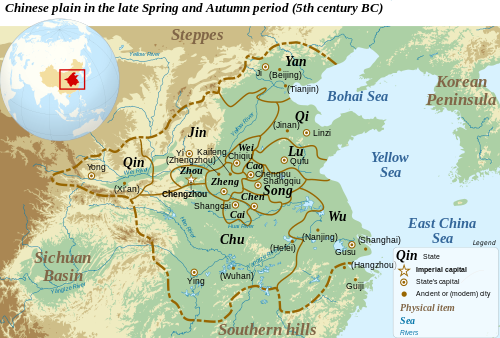Wey (state)

Wey (simplified Chinese: 卫; traditional Chinese: 衞; pinyin: Wèi, commonly spelled Wey to distinguish it from the other Wei state) was an ancient Chinese state that was founded in the Zhou Dynasty and rose to prominence during the Spring and Autumn Period. Its rulers were of the surname Ji (姬), the same as that of the rulers of Zhou. Its original location was on the North China Plain just east of the Shanxi plateau and north and west of the Yellow River. Jin was to the west and Cao to the east.
Early history
The history of Wey dates back to the beginning of the Zhou Dynasty, when the younger brother of King Wu of Zhou was given a fief centred around Zhaoge, the capital of the Shang Dynasty; in later years the fief was further expanded and given the name Wey.
The original feudal rank of the rulers of Wey was elevated to that of hou (roughly equivalent to Marquis) by bribery; during the turmoil in 771 BC, when the Zhou capital of Haojing was sacked and the crown prince fled east, the state of Wey protected and escorted the prince, and for this the rulers were further elevated to gong (equivalent to a Duke).
Spring and Autumn Period
The State of Wey was at its peak during the early Spring and Autumn Period, under Duke Wu of Wey, who reigned for 55 years. In the reign of subsequent rulers, however, the state was plagued by succession troubles, until Duke Yi of Wey took the throne; his dissolute rule and obsession with cranes weakened the state, and in the eighth year of his reign the Rong peoples successfully attacked the capital at Chaoge, killing the Duke and nearly destroying the state as well (660BC).
It was only with the aid of Duke Huan of Qi that the state was eventually restored, with its capital moved to Chuqiu.
In 632 BC Wey was once conquered by Duke Wen of Jin, because when Duke Wen (called Chong'er then) exiled to Wey, Duke Wen of Wey hadn't treated him well, and Duke Cheng of Wey (son of Duke Wen of Wey) was nearly poisoned by Duke Wen of Jin, but eventually the state was restored. (Before the Battle of Chengpu, when Chu was attacking Song, Jin attacked Wey and Cao as a diversion.)
In 492 BC, Duke Chu of Wey (出公) succeeded the throne from his grandfather Duke Ling (灵公), while his father Kuaikui (蒯聩), who was the heir of Duke Ling, had been deposed and exiled. To get the throne, Kuaikui fought against his own son and managed to exile Duke Chu in 481 BC, and was titled as Duke Zhuang (latter) (后庄公), but was killed three years later. Duke Chu was restored in 475 BC. The conflict between father and son weakened Wey, and Wey soon became attached to House of Zhao of Jin.
Downfall And Ending
In 346 BC, the duke of Wey degraded himself to a marquis. In 320 BC, the marquis of Wey again degraded himself to only a jun (lord). And by then Wey only possessed a county called Puyang (濮阳). In 254 BC, King Anxi of Wei(魏) killed Lord Huai of Wey (卫怀君), but two years later he declared his son-in-law to be lord of Wey, so Wey became a dependency of the Wei Kingdom. In 239 BC, Qin occupied Puyang, and Wey migrated to Yewang (野王) in order to preserve its existence.
The state was so weak that it even outlived Qin Shihuang, presumably because his mother's family were living there. The state was only abolished in 209 BC when Qin Er Shi deposed Lord Jiao of Wey (卫君角), 2 years before the collapse of the Qin Dynasty.
List of Rulers
Partial list of rulers from the Cambridge History of Ancient China, page 26 ('Gong' means 'Duke'): Wu Gong 812-758; Zhuang Gong 757-735; Huan Gong 734-719; Xuan Gong 718-700; Hui Gong 699-669; Yi Gong 668-661; Dai Gong 660; Wen Gong 659-635; Cheng Gong 634-600; Mu Gong 599-589; Ding Gong 588-577; Xian Gong 576-559; Shang Gong 558-547; Xian Gong 546-544; Xiang Gong 543-535; Ling Gong 534-493; Chu Gong 492-481; Zhuang Gong 480-478;
